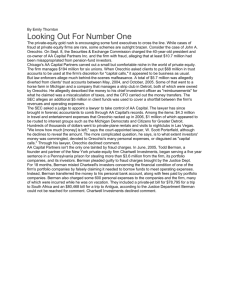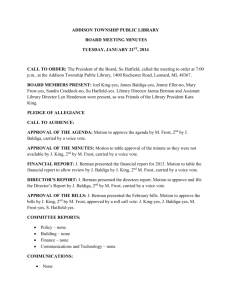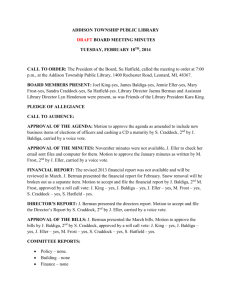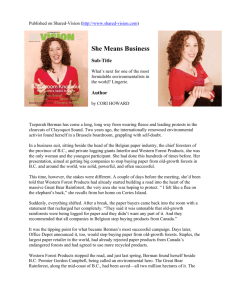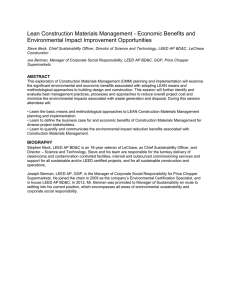Document 11172321
advertisement
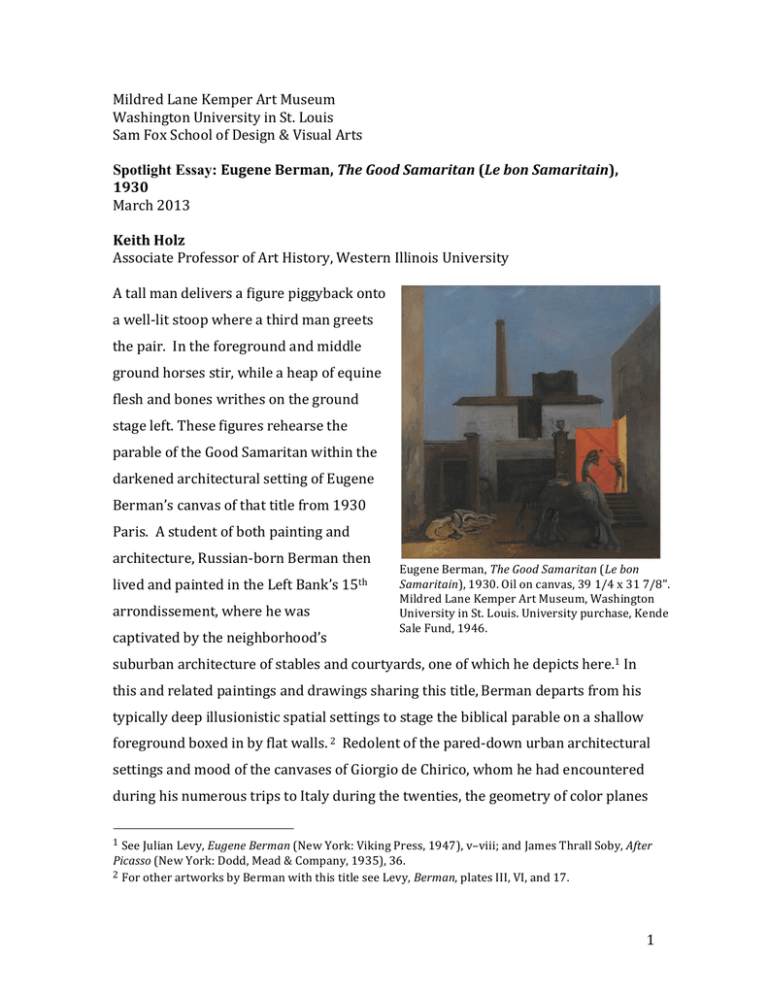
Mildred Lane Kemper Art Museum Washington University in St. Louis Sam Fox School of Design & Visual Arts Spotlight Essay: Eugene Berman, The Good Samaritan (Le bon Samaritain), 1930 March 2013 Keith Holz Associate Professor of Art History, Western Illinois University A tall man delivers a figure piggyback onto a well-­‐lit stoop where a third man greets the pair. In the foreground and middle ground horses stir, while a heap of equine flesh and bones writhes on the ground stage left. These figures rehearse the parable of the Good Samaritan within the darkened architectural setting of Eugene Berman’s canvas of that title from 1930 Paris. A student of both painting and architecture, Russian-­‐born Berman then Eugene Berman, The Good Samaritan (Le bon Samaritain), 1930. Oil on canvas, 39 1/4 x 31 7/8". Mildred Lane Kemper Art Museum, Washington University in St. Louis. University purchase, Kende Sale Fund, 1946. lived and painted in the Left Bank’s 15th arrondissement, where he was captivated by the neighborhood’s suburban architecture of stables and courtyards, one of which he depicts here.1 In this and related paintings and drawings sharing this title, Berman departs from his typically deep illusionistic spatial settings to stage the biblical parable on a shallow foreground boxed in by flat walls. 2 Redolent of the pared-­‐down urban architectural settings and mood of the canvases of Giorgio de Chirico, whom he had encountered during his numerous trips to Italy during the twenties, the geometry of color planes 1 See Julian Levy, Eugene Berman (New York: Viking Press, 1947), v–viii; and James Thrall Soby, After Picasso (New York: Dodd, Mead & Company, 1935), 36. 2 For other artworks by Berman with this title see Levy, Berman, plates III, VI, and 17. 1 identical with the picture plane are as close as Berman would ever come to Cubist picture construction. This paper asks what clues the canvas betrays of Berman’s engagement with the history of art as well as with his timely concerns as a stateless Russian Jew living in a neighborhood of fellow immigrants and refugees who were subjected to the Third Republic’s then tightening refugee and residency regulations. It also seeks to illuminate the pictorial language of this painting in relation to Berman’s aspirations as a gallery artist and in relation to critical efforts to categorize the diverse styles and practices of emerging painters at the time. Modernism’s futurity makes it easy to forget that modern painters on occasion did look back to Old Masters to rejuvenate their pictorial practices. Such is the case here. The Good Samaritan, a canvas in the Louvre from c. 1650, then believed to be painted by Rembrandt but now attributed to Constantijn-­‐Daniel van Renesse, appears to have informed Berman’s adoption of this theme. For Berman, his look back was also a gaze averse to any future associated with the Bolshevik Revolution and Constantijn-­‐Daniel van Renesse, The Good Samaritan, c. 1650. Oil on canvas, 44 7/8 x 53 1/8". Musée du Louvre, Paris. Photo © RMN-­‐Grand Palais; licensed by Art Resource, New York; photo by Jean-­‐Gilles Berizzi. the upending of Russian society and artistic practice that also brought the downfall and flight of Berman’s affluent banking family and his relocation, together with his painter brother, Leonid, through Finland and London to Paris by the end of 1918. Compared to the decidedly nostalgic and romantic canvases and stage designs Berman produced over his long career and for which he has remained best known—compositions often dominated by classicizing architectural ruins set within perspectival spaces—Berman’s Good Samaritan 2 compositions, which combine literary sources within rigorous architecturally determined designs, were less estranged from the absolute propositions and radical practices of the Constructivists and their Cubist contemporaries in the West than any other pictures in his oeuvre. Writing in 1947 about this series and its difference from the rest of Berman’s oeuvre, his dealer Julian Levy—who had met Berman before 1930 in Paris, exhibited his art at his New York gallery, and facilitated his emigration to the United States in 1935—noted: “This kind of organization had been a solution when Berman was trying to combine representational images with the architectonics of Picasso’s cubism.…[The] pictures would have looked almost as if they were abstractions had they not been so evidently arrangements of recognizable courts, walls and windows.”3 In the Kemper Art Museum’s canvas, the courtyard walls establish an enclosure of architectonically organized, overlapping, rectilinear, colored planes across a picture plane further structured by five rectilinear doors, windows, and their openings. Together with the nearly cloudless sky and dirt of the foreground yard, they blanket the surface of the canvas. The edges of walls, rooflines, and vertical smokestacks also impose geometry upon the natural blue sky. Symmetry is enhanced through the pair of piers flanking the central, black, rectangular stable-­‐door opening. Each pier is crowned with a vase, although pentimenti suggest that Berman reworked this aspect of the composition, as only the vase on the right remains fully visible. What precisely captivated Berman in the Louvre’s canvas remains unknown, but a few general commonalities should be noted. Like the author of the Dutch canvas, the thirty-­‐year-­‐old Jewish painter from Russia cast the New Testament theme in a dim nocturnal light with characters on a proscenium-­‐like platform, surrounded by the unadorned, flat planes of the courtyard’s inner walls. Although the painting’s darkness renders it nearly illegible, one is still able to discern the drift from left to right of human protagonists passing horses as they approach the illuminated porch 3 Ibid., viii. 3 at the right—a procession shared with the older painting. Furthermore, adoption of the Good Samaritan theme in both paintings carries an additional dimension to the meaning of neighborliness among different ethnic groups. Such a reading in Berman’s painting was suggested early on by Levy, whose 1947 recollection of his first encounter with Berman’s work is telling: The first pictures of his which I saw were of the stables and courtyards of Paris, a period which we might call the period of the “Good Samaritan” as that title was given to several variations of the courtyard theme. The old tale of the biblical Samaritan provides a good indication to the mood of those paintings: the neighborhood neighborliness lifted parabolically by Berman’s interpretation to the level of some contemporary myth.4 Identification with Rembrandt’s residence in a Jewish neighborhood beginning in 1639, where neighborhood Jews modeled for his religious figures, including Jesus, may well have weighed on Berman’s mind. He lived in the multi-­‐ethnic 15th arrondissement, a nearly suburban neighborhood with one key similarity to Rembrandt’s quarter in Amsterdam: both served as urban havens for refugees from many lands. After the stock market crash amid mounting economic depression, an influx of refugees joined the highly concentrated immigrant populations already living in Parisian districts such as the 15th. Migrants and especially refugees were subjected to federal laws imposed to regulate foreigners. Already in 1922, the Soviet government had stripped Russian emigrants like Berman of their nationality, leaving them stateless. Russian refugees in Paris were also often subject to refoulement, or forced repatriation to their homeland, a fate Berman would surely have done anything to avoid.5 With the onset of the depression, public outcry against immigrants taking French jobs and other forms of xenophobia and anti-­‐ 4 Ibid., v-­‐vi. 5 Mary Dewhurst Lewis, The Boundaries of the Republic Migrant Rights and the Limits of Universalism in France, 1918–1940 (Stanford, CA: Stanford University Press, 2007), 158, 159. 4 Semitism were on the rise.6 Russians in France suffered higher unemployment rates and for longer periods than previously, and they were also arrested for vagrancy more often than other foreigners.7 In this environment, Berman’s experience as a Russian Jew in Paris would have triggered instincts of self-­‐preservation but also heightened concern for the destabilized status of his fellow countrymen and other uprooted refugees. Viewed in this context, Berman’s choice to restage the story of Jesus’ account of the injured, possibly Jewish, traveler aided by a Samaritan (Samaritans and Jews typically scorned one another) was no simple engagement with an Old Master canvas from the French state’s premier art museum. Rather, it amounts to a timely recognition of the potential for humane neighborly relations across painful ethnic and religious divisions under state-­‐sanctioned duress that the émigré painter was beginning to witness in 1930.8 The dynamics of this tension may well be staged in this canvas, particularly in the disjunction between the setting and its occupants. In contrast to the reassuring stability of the simple, even protective, architectural surround, the tranquility of the scene has been disrupted by the mysteriously threatening aura suggested by the afflicted fallen horse and perhaps the injured man delivered by the Samaritan as well. For a stateless Russian Jewish migrant during this insecure period of rapidly shifting attitudes toward foreigners and a tightening dragnet of legislation toward refugees and migrants, even toward Russian Jews who had enjoyed a decade of relatively little turbulence, the stakes of demonstrating assimilation to French society and professional belonging had never been higher. Over the course of the 1920s, Berman, despite his status as a foreigner, had exhibited regularly at Paris galleries and had enjoyed moderate success as a painter. The Parisian art market and the discourse attending it had been quick to categorize 6 Ibid., 173. 7 Ibid., 171–72. 8 Another Jewish painter in Paris, the Belorussian Chaim Soutine painted his Carcass paintings from 1924 to 1929, a theme previously pioneered by Rembrandt. Like Berman’s Good Samaritan works that triangulated with an outlying Parisian neighborhood and a canvas attributed to Rembrandt, Soutine’s paintings triangulated with Parisian slaughterhouses of similar outlying, déclassé Parisian neighborhoods and Rembrandt’s paintings of bovine carcasses. 5 Berman’s paintings of the twenties and early thirties. As early as 1924, at an exhibition at the Galerie Drouet, Berman and his fellow students from the Academie Ranson had labeled their own pictures in this post-­‐Cubist period “Neo-­‐Romantic.” An additional, not exclusively pictorial term, “Neo-­‐humanism,” was coined by critic Waldemar George in 1930 and favorably applied to Berman’s new painting. Christopher Green has summarized well the complicated yet influential critical significance of George in Paris at this time. Discussing George’s notion of Neo-­‐ humanism that he developed when he founded his art journal Formes, Green notes that George argued for new art to turn away from outright progress and modernism and return to the past, a maneuver he found exemplified in Berman’s art. Among the other artists the assimilated senior critic named as Neo-­‐humanists in the first issue of Formes were Giorgio de Chirico and Alberto Savinio (de Chirico’s brother), together with “our young school” (the Neo-­‐Romantics foremost) that included, along with Berman, Christian Bérard and Paul (Pavel) Tschelitchew.9 To pinpoint more precisely Berman’s location in the networks and discourses of the rapidly internationalizing Paris art world, it is illuminating to compare the persons and territorial trajectories of Berman and George. Like Berman, George was a Jew who had fled to France as a political refugee—Berman from Russia in 1918 and George from Poland in 1911. By the late 1920s, both men regarded themselves as well along the path of assimilation to French society and culture, a process they embraced. While little is known about Berman’s perspective on his own Jewish identity, George identified with the French Jews whose families had been in France for generations—the so-­‐called Israelites. But by 1930, even established Jews had come to fear that the new waves of Jewish refugees would fan the flames of anti-­‐ 9 See Christopher Green, Art in France 1900–1940. Pelican History of Art (New Haven: Yale University Press, 2000), esp. 222–23. In this work Green synthesizes pioneering work on Waldemar George conducted by Romy Golan and Matthew Affron, especially Golan’s Modernity and Nostalgia: Art and Politics in France between the Wars (New Haven, CT: Yale University Press, 1995); and Affron’s “Waldemar George: A Parisian Art Critic on Modernism and Fascism,” in Fascist Visions: Art and Ideology in France and Italy, ed. Matthew Affron and Mark Antliff (Princeton, NJ: Princeton University Press, 1997), 184–204. 6 Semitism. Berman’s frequent turn to the Italian classical tradition (in the majority of his other paintings) and to Rembrandt (in the Good Samaritan paintings and drawings), made him an exemplar of George’s Neo-­‐humanist agenda that celebrated artists engaged with a recovery of European cultural traditions. Berman’s privileged Russian past and antipathy toward the Soviet regime that had ruined his family’s station in St. Petersburg and imprisoned him for two months in 1918, paired with his artistic pursuits in Paris and the acculturation that entailed, set him on a course of synthesizing disparate present-­‐day traditions as well as reconciling art of the past with what was new in Paris. Despite the gentle syncretic character of his art at this time, Berman’s Good Samaritan canvas is notably void of Jewish or “primitivist” motifs or style (East European, Russian, or otherwise), either of which might have pulled him into the crosshairs of xenophobic and anti-­‐Semitic sightings within the right-­‐leaning French public sphere. Instead, The Good Samaritan, with its balance approaching symmetry and its reconciliation of dramatic figures within a geometrically stable and sheltering surround, betrays its proximity to the French classical tradition—Poussin, Puvis, or even Cézanne and Derain—just as it marks out its distance from the radical Russian or Western avant-­‐gardes of the day. In this respect, American collector and Wadsworth Athenaeum curator James Thrall Soby’s comment that Neo-­‐Romantic paintings are “free at last from the burden of revolutionary ideas”10 rings true. By staging the injured transient and agitated horses within a protective architectonic surround, this canvas seems in tune with Baudelaire’s 1863 challenge that modern life painters come to terms with the Old Masters, and his definition of modernity as “the ephemeral, the fugitive, the contingent, the half of art whose other half is the eternal and the immutable.“11 Berman gives us both halves in this version of The Good Samaritan. 10 Soby, After Picasso, 8. 11 Charles Baudelaire, “The Painter of Modern Life,” in his The Painter of Modern Life and other essays, ed. and trans. Jonathan Mayne (London: Phaidon Press, 1964), 13. 7 It is important to acknowledge that the Neo-­‐Romantic painters’ work was not always met with enthusiasm. Those committed to the rigorous development of Cubism and its legacy were often harshly critical. Consider the view of German expatriate art historian and critic Carl Einstein. Around 1930, Einstein could offer only scorn for what he took to be the facile pictures of the Neo-­‐Romantics and others. Although it was the paintings of Christian Bérard, Berman’s fellow student from the Academie Ranson whose art had come to embrace fashion illustration, that triggered Einstein’s ire, it is not difficult to imagine Berman’s work as well targeted by his acerbic critique of contemporary painting. In an often-­‐overlooked essay, “The Little Picture Factory” of 1931, Einstein delivered an institutional critique of the Paris art trade. Particularly offensive to Einstein was the robust market for fashionable paintings, which, according to him, Neo-­‐Romantics like Berman epitomized. Einstein wrote: The fabrication of pictures without worldview or risk is lower than the traffic in young women, for the facile dauber is menaced by no punishment, only comfortable income.…Many people believe in their talent, mostly because they sit in Paris, where the legacy of painting flies around in tatters like nowhere else. One even belongs to the School of Paris and addresses cousin Cézanne in the familiar. One finally destroys the sham of a dubious commodity market. The abused Seine is dammed up with oil paint, the docks sink before the shame, Notre Dame is violated, and nudes, painted right down to the enameled skin, swing over moth-­‐eaten sofas that give off outdated anecdotes and insect-­‐spray.12 12 “Bilderfabrikation ohne Anschauung und Wagnis ist niederer als Mädchenhandel, da dem beflissenen Pinsler keine Strafe droht, sondern bequeme Rente. . . . Viele Leute glauben an ihr Talent, ungefähr weil sie in Paris sitzen, wo die Fetzen malerischer Erbschaft nur so umherfliegen. Man gehört eben der Pariser Schule an und duzt den Vetter Cézanne. Man zerstöre endlich den Bluff einer fragwürdige Warenmarke. Die missbrauchte Seine ist von Ölfarbe gestaut, die Quais versinken vor Scham, Notre Dame wird genotzüchtigt, und Akte, heruntergemalt bis unter die emaillierte Haut, überschaukeln vermottete Kanapees, die überalterte Anekdoten und Flytox ausdünsten.” Carl Einstein, “Kleine Bilderfabrik,” Weltkunst 5 (April 1931), 2–3, reprinted in Carl Einstein (1885–1940) Kleine Bilderfabrik Eine Auswahl unbekannter Aufsätze (Siegen: Universität-­‐Gesamthochschule Siegen, 1988), 24–26 (translation mine). 8 What Einstein found so reprehensible in the work of George’s beloved Neo-­‐ Romantics, however, came to be embraced with warmth and discernment across the Atlantic in the writings of James Soby. In his 1935 book, After Picasso, Soby characterized well the canvases Berman commenced upon returning from Italy to Paris in 1930: From his drawings, he painted a series of pictures of courtyards which have centers of dramatic excitement in contrast to the calm of the buildings beyond. Compared to the uncommunicative silence of his interiors, these paintings are the nearest Berman has come to commentary. In pictures like The Wounded and Le Bon Samaritain, figures bend over a wounded man and horses stand ready to be ridden away. The light on these activities is derived from Rembrandt, and falls from a doorway on the right; there is no other light except the moonlight on the roofs and the dull glow from windows beyond. The painter’s melancholy is more active here, and no longer suggests a calm malaise but a quiet concern.… Using broad and fairly pure passages of color, he began to lighten his palette and to smooth out the texture of the pigment.…The rich greens, browns and grays of the buildings and the figures are framed against an atmospheric background of dark blue.13 This description is directed at another painting of the same title, formerly in the collection of Soby’s friend and early Museum of Modern Art board member Edward M. M. Warburg, but it also rings true for the canvas in the collection of the Kemper Art Museum. Stationing Berman’s canvas amid key social and discursive contexts of the early 1930s, it is possible to regard this painting as a hybrid creation of the migrant imaginary seeking assimilation and acculturation. Firstly, the Good Samaritan theme adapted from Rembrandt appears to fuse Berman’s hope for better ethnic relations in his neighborhood as well as improved relations with French immigration 13 Soby, After Picasso, 35–36. 9 authorities. Secondly, the modernist assertion of flat, architectonic planes to frame a stage set amounts to a weak nod toward Cubist picture construction while retaining the architectonic framing of a rather conventional proscenium stage to host the biblical narrative that Berman found so timely. Thirdly, the general maneuver of taking art backwards—to an Old Master canvas depicting a biblical parable—to reinvent painting anew nudges Berman’s painting into a modernist tradition attuned to Baudelaire. In following each of these dualities negotiated in paint by Berman, we are able to discern how Berman’s painting also staked out a middle ground for itself between opposing critical factions concerned with contemporary Parisian pictorial aesthetics. With Berman’s residency and welcome in France never so uncertain, and critical views of his art so polarized, The Good Samaritan brokers these differences without effacing them, perhaps with the hope to ameliorate current and future discord. To cite this essay, please use the following: Keith Holz, “Spotlight Essay: Eugene Berman, The Good Samaritan (Le bon Samaritain) (1930),” Mildred Lane Kemper Art Museum, Spotlight Series, March 2013, http://kemperartmuseum.wustl.edu/files/spotlightMAR13.pdf (accessed on [insert date]). 10
